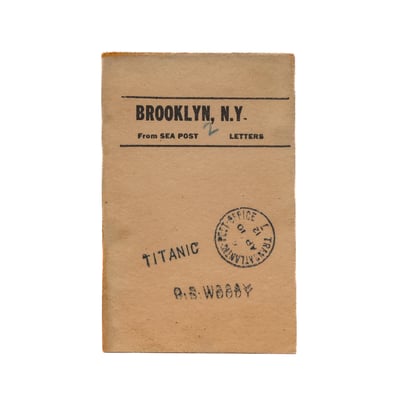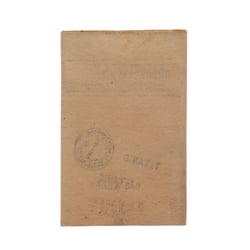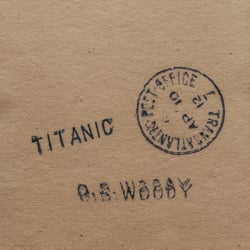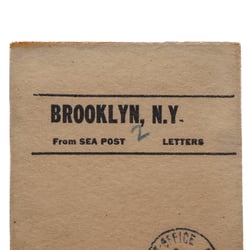The Mail of the Titanic
The object, Lot 1500, is a facing slip from the mail room of the great ocean liner, which sank on her maiden voyage across the Atlantic on the night of April 14-15, 1912. Postal clerks used these papers for sorting mail. Each had a pre-printed destination. As the clerks sorted mail, they hand stamped the ship’s postmark and name, together with the name of the individual clerk who had handled that portion of the mail. The example at Alex Cooper was imprinted for Brooklyn, New York, stamped with the Transatlantic post-office date stamp on April 10, then “Titanic,” and finally the name, “O S Woody,” one of the clerks.

Lot 1500, Rare RMS "Titanic" Postal Ephemera, April 10, 1912
The “Titanic” was a Royal Mail Steamer, with a contract to carry mail from Great Britain and the U.S., which extended to all mail within the Universal Postal Union. Her crew included five postal clerks – three employees of the Royal Mail and two from the United States Post Office Department. They operated a post office aboard ship, but their principal responsibility was to sort the vast array of mail on its way from Britain and Europe to the United States. The ship is thought to have been carrying well over a million items, some 3,300 large sacks of envelopes and packages, when she sank. These clerks were at the top of their game, each capable of sorting 60,000 pieces of mail per day.
Oscar Scott Woody, a native of North Carolina, had worked for years sorting mail in railway post offices. His transfer to a mail steamer was a significant advance in his career. This run home would complete his first trip across the Atlantic. Securing a berth on the “Titanic,” the finest steamer of the type ever built, was a huge honor. On the evening of the 14th, Woody celebrated his birthday with the other clerks. The impact of the iceberg interrupted their celebration, however. The men went right into action trying to haul mail up from below decks, because water was pouring into their sorting area. The effort was futile though. Every one of the clerks perished, and not a piece of their mail was saved.


Left: Oscar S. Woody. Right: A map of compartments on the Titanic. (Photo credit: Heritage Auctions)
A week later, the crew of the cable ship “Mackay-Bennett” recovered Woody’s body, buoyed in the freezing water by a life preserver. They found a watch and other personal articles, with a number of these facing slips, in his pockets. Woody was buried at sea, and his widow later received the personal effects, including the facing slips.
It has been suggested that Woody pulled these slips as the ship was sinking, in an attempt to document what mail was lost. This doesn’t make much sense, though, given the huge volume of mail on the ship. The clerk would have had to untie the bundles to remove the slips, too, which seems highly unlikely. All of the known slips have a postmark dated April 10, with Woody’s name stamp. All that have come to our attention have some flaw in the stamping – nearly always with Woody’s name doubled. Most likely, Woody had prepared these slips, but when he realized that they were hard to read, he did them over again. The imperfect ones, he stuffed into his pocket, meaning to throw them out when he could spare a moment. He never got around to it, however.



A few of these slips have made their way onto the market. A Baltimore collector bought the present example from Matthew Bennett Auctioneers in January, 1970, and has held it ever since. Many of the rest are in museums or institutional collections. Now, it could be your turn to own a piece of RMS Titanic history, something that is not often available to the general public.
Lot 1500, Rare RMS “Titanic” Postal Ephemera, April 10, 1912, is in very good condition with a general toning and light stains around the edges consistent with seeping water. It is estimated at $5,000 - $8,000, easily a small price to pay for a piece of history that has entangled itself in the minds of millions since it’s tragic and horrific downfall.
Richard Hall
Specialist of Rare Books & Ephemera
richard@alexcooper.com
